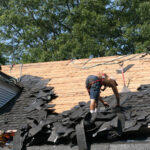A study by the Insurance Institute for Business and Home Safety (IBHS) found roof damage from smaller hailstones may be much more significant than previously believed. It’s a finding that one plaintiffs’ lawyer has already cited as potential support for roof claims.
“This data challenges long-standing opinions by insurance company experts that have denied or minimized damage from small hail,” blogged attorney Chip Merlin, whose law firm has offices in 10 states. “If the science says these storms age shingles years ahead of schedule and set the stage for catastrophic failure in later storms, then dismissing that damage at the claims desk is at odds with the evidence.”
An insurance defense lawyer said the study shows only that smaller hail can cause damage over time, much like rain or sun, and long-term wear and tear is often excluded from homeowners’ policies.
“There must be a singular event that causes actual physical damage to the property,” said John Riordan, a West Palm Beach attorney with the Kelley Kronenberg law firm. “Most policies have exclusionary language, so those kinds of claims over months or years from multiple hailstorms would not be covered.”
The IBHS study, published last week in the peer-reviewed journal Frontiers in Materials, found that concentrations of sub-severe hailstones (less than an inch in diameter) can “significantly reduce the roof cover’s resistance to future large hail events, and exacerbate the natural aging of asphalt shingles.”

The authors are Brenna Meisenzahl, Ian Giammanco and Faraz Hedayati, all of whom are researchers or managers at IBHS, the property insurance industry’s vaunted research center, with testing sites in South Carolina. Giammanco is managing director of atmospheric science for IBHS.
“This suggests that frequent sub-severe hailstorms may pose a greater threat to roof longevity than previously recognized and is a driving factor in the growing hail risk in the United States that is not accounted for in current durability standards or risk assessments,” the authors noted.
For years, smaller hail has been but a minor concern to property insurers and researchers. The National Weather Service classifies hail as “severe” only when stones exceed 25.4 millimeters (1 inch in size). Roof damage was largely considered to be limited to storms the produce the larger-sized stones. Riordan noted that engineers have generally agreed that most shingle-damage events come from hailstones that are 1.5 inches or larger.
But some claims adjusters and claimants’ attorneys have long said that in certain cases, smaller hail leads to rapid deterioration of shingles and can lead to water intrusion.
“It can do some damage,” said Ben Mandell, an independent adjuster who has worked roof claims across the South. He has produced photos of shingles that a carrier said showed only weathering and age, but which he believes were stripped of their granules by smaller hail and should be replaced. When the rock-hard granules are gone, the substrate is exposed, leading to a greater risk of leaks, he said.
“This is what we’ve found to be true, and we’re the ones up on the roof,” Mandell added.

To conduct the study, the IBHS research team froze water in molds and used a “hail cannon” to fire the ice at properly installed roof samples. They then allowed a year of natural weathering, and then fired larger hailstones at the shingles. The scientists employed machine vision and an algorithm to determine the loss of granules.
The cumulative granule loss from the sub-severe impacts in a series of tests exceeded the total granule loss from a 2-inch hailstone impact, the study found.
“Our findings show that asphalt shingles exposed to both natural weathering and sub-severe impacts were approximately ten times more susceptible to future damage from subsequent severe hail events,” the authors wrote. “We hypothesize that repeated exposure to these sub-severe events may dislodge enough granules to accelerate shingle deterioration, increasing vulnerability to future hail damage.”
The results also showed that so-called impact-resistant shingles – designed to withstand more flying debris – fared little better coventional shingles in cumulative granule loss.
It’s possible that the study and its authors could be used in claims litigation. Some states court rules may allow it. In Florida, though, published studies can generally be used only in cross-examination, to challenge witness reports. Lawmakers in Florida, a state once beset with roof claims that insurance industry advocates called fraudulent or exaggerated, in 2022 famously disincentivized some roof and hail claims lawsuits. The legislature banned one-way attorney fees and assignment-of-benefit (AOB) agreements—arrangements with roof contractors that had helped produce thousands of claims lawsuits.
But many other states continue to allow AOBs.
While weather events appear to be increasing in parts of the country, it’s difficult to know if hailstorms are on the rise, particularly those that produce smaller stones. The Insurance Information Institute tracks only those claims from hailstones that are 1-inch or larger. The data show 5,373 claims in 2024, a dip from 2023 but a 17% rise from 2020. The National Insurance Crime Bureau reported a 2% rise in hail-loss claims from 2018 to 2020.
Texas and Kansas seem to lead the pack every year, the Insurance Information Institute reported. Texas had 878 claims from major hail events in 2024—almost twice as many as Kansas.
Carriers have recognized the impact of hail claims. In 2022 financial reports, three of the five largest publicly traded property/casualty insurers identified hail as a significant issue, the IBHS study said.
“Hail has moved to the forefront of loss drivers and will continue to impact home and business owners, as it is responsible for an estimated 50% to 80% of annual damages” from severe convective storm events, Cape Analytics reported this year, the study noted.
The full IBHS study can be seen here.
Top photo: Adobe Stock image
Was this article valuable?
Here are more articles you may enjoy.


 UPS Ripped Off Seasonal Workers With Unfair Pay Practices, Lawsuit Alleges
UPS Ripped Off Seasonal Workers With Unfair Pay Practices, Lawsuit Alleges  AIG Partners With Amwins, Blackstone to Launch Lloyd’s Syndicate Using Palantir
AIG Partners With Amwins, Blackstone to Launch Lloyd’s Syndicate Using Palantir  Twice Injured Firefighter Loses Second Workers’ Compensation Claim
Twice Injured Firefighter Loses Second Workers’ Compensation Claim  ‘Door Knocker’ Roofers Were Everywhere. NC Farm Bureau Saw an Opportunity
‘Door Knocker’ Roofers Were Everywhere. NC Farm Bureau Saw an Opportunity 


